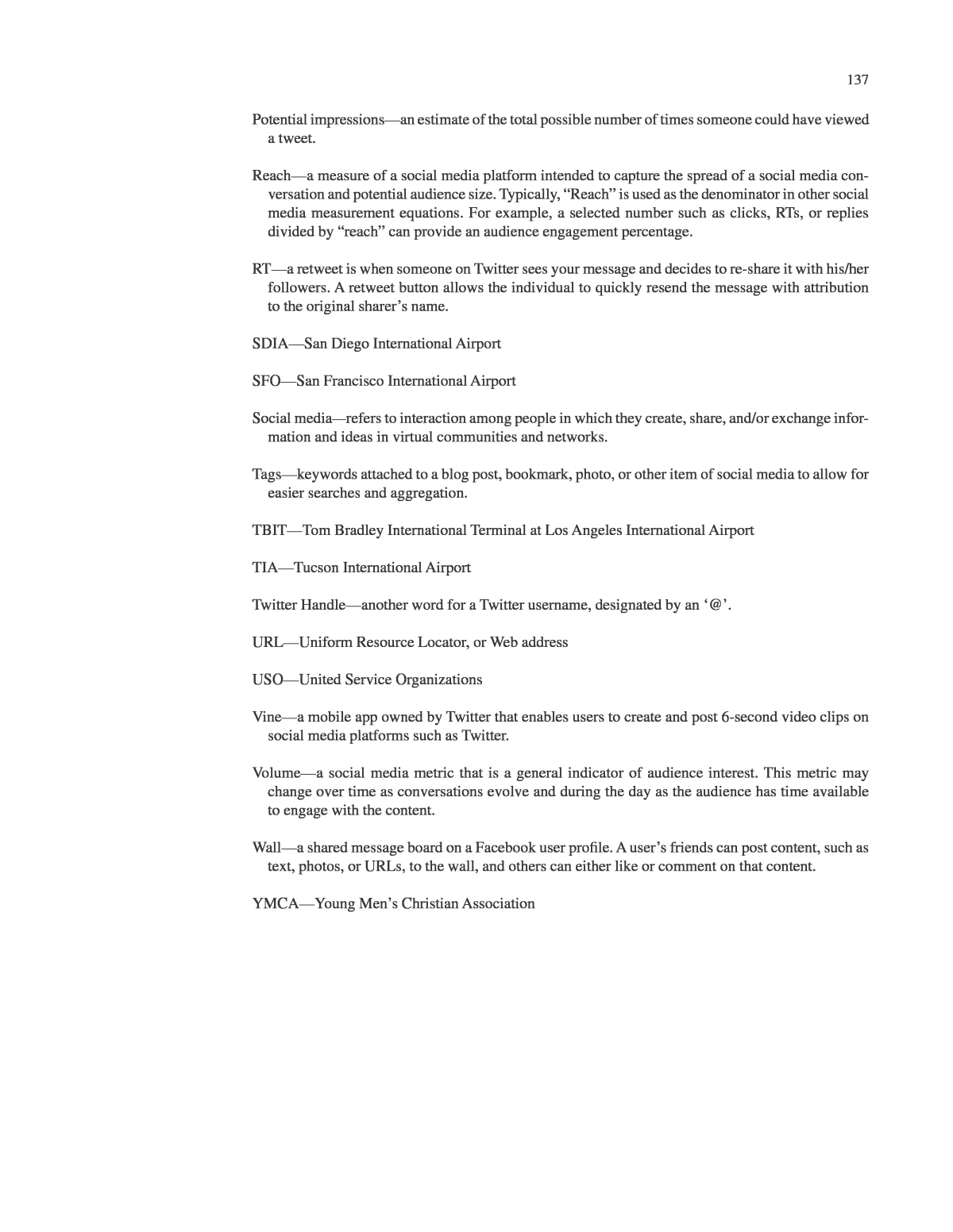

Below is the uncorrected machine-read text of this chapter, intended to provide our own search engines and external engines with highly rich, chapter-representative searchable text of each book. Because it is UNCORRECTED material, please consider the following text as a useful but insufficient proxy for the authoritative book pages.
136 GLOSSARY OF TERMS, ABBREVIATIONS, AND ACRONYMS AEGâAnschutz Entertainment Group ARFFâAircraft Rescue and Firefighting Facility bitlyâa free URL shortening service that provides statistics for the links users share online. bitly is popularly used to condense long URLs to make them easier to share on social networks such as Twitter. BOSâBoston Logan International Airport CAKâAkronâCanton Airport CRWâCharleston Yeager Airport DAAâDublin Airport Authority DFWâDallas/Fort Worth International Airport DUBâDublin Airport EIAâEdmonton International Airport Engagementâa social media measure that captures the how and what of audience interaction with social media content. Facebook shares and posts, RTs (retweets), and website/video click-throughs are monitored to determine engagement level and engagement percentage. ESPâEnhanced service portal EUGâEugene Airport Hashtagâa tag used on the social network Twitter as a way to annotate a message. A hashtag is a word or phrase preceded by a â#.â Example: #yourhashtag. KPIsâKey Performance Indicators LAXâLos Angeles International Airport Likeâa âLikeâ is an action that can be made by a Facebook user. Instead of writing a comment for a message or a status update, a Facebook user can click the âLikeâ button as a quick way to show approval and share the message. MERFâMarine Emergency Response Facility MKEâMilwaukee General Mitchell International Airport MOAâMall of America MSPâMinneapolisâSt. Paul International Airport Profilesâinformation provided by users about themselves when signing up for a social networking site. Postâan item on a blog or Facebook.
137 Potential impressionsâan estimate of the total possible number of times someone could have viewed a tweet. Reachâa measure of a social media platform intended to capture the spread of a social media con- versation and potential audience size. Typically, âReachâ is used as the denominator in other social media measurement equations. For example, a selected number such as clicks, RTs, or replies divided by âreachâ can provide an audience engagement percentage. RTâa retweet is when someone on Twitter sees your message and decides to re-share it with his/her followers. A retweet button allows the individual to quickly resend the message with attribution to the original sharerâs name. SDIAâSan Diego International Airport SFOâSan Francisco International Airport Social mediaârefers to interaction among people in which they create, share, and/or exchange infor- mation and ideas in virtual communities and networks. Tagsâkeywords attached to a blog post, bookmark, photo, or other item of social media to allow for easier searches and aggregation. TBITâTom Bradley International Terminal at Los Angeles International Airport TIAâTucson International Airport Twitter Handleâanother word for a Twitter username, designated by an â@â. URLâUniform Resource Locator, or Web address USOâUnited Service Organizations Vineâa mobile app owned by Twitter that enables users to create and post 6-second video clips on social media platforms such as Twitter. Volumeâa social media metric that is a general indicator of audience interest. This metric may change over time as conversations evolve and during the day as the audience has time available to engage with the content. Wallâa shared message board on a Facebook user profile. A userâs friends can post content, such as text, photos, or URLs, to the wall, and others can either like or comment on that content. YMCAâYoung Menâs Christian Association
